Economics for Business: Polo Mint Demand and Supply Analysis Report
VerifiedAdded on 2021/01/02
|15
|3396
|305
Report
AI Summary
This report provides a comprehensive analysis of the economics of Polo Mints within the United Kingdom's market. It begins with an introduction to business economics, emphasizing the role of supply and demand in determining prices. The main body of the report delves into the demand and supply equilibrium, illustrating how shifts in demand and supply impact prices. It examines factors influencing changes in demand, such as the price of complementary and substitute goods, income levels, consumer preferences, and future price expectations. Furthermore, the report explores factors affecting the supply of Polo Mints, including production costs, technology, transport conditions, and the prices of related goods. Diagrams are used to visually represent the effects of these factors on price and quantity. The report concludes by summarizing the key findings and emphasizing the interplay of supply and demand in the Polo Mint market. References are provided at the end.
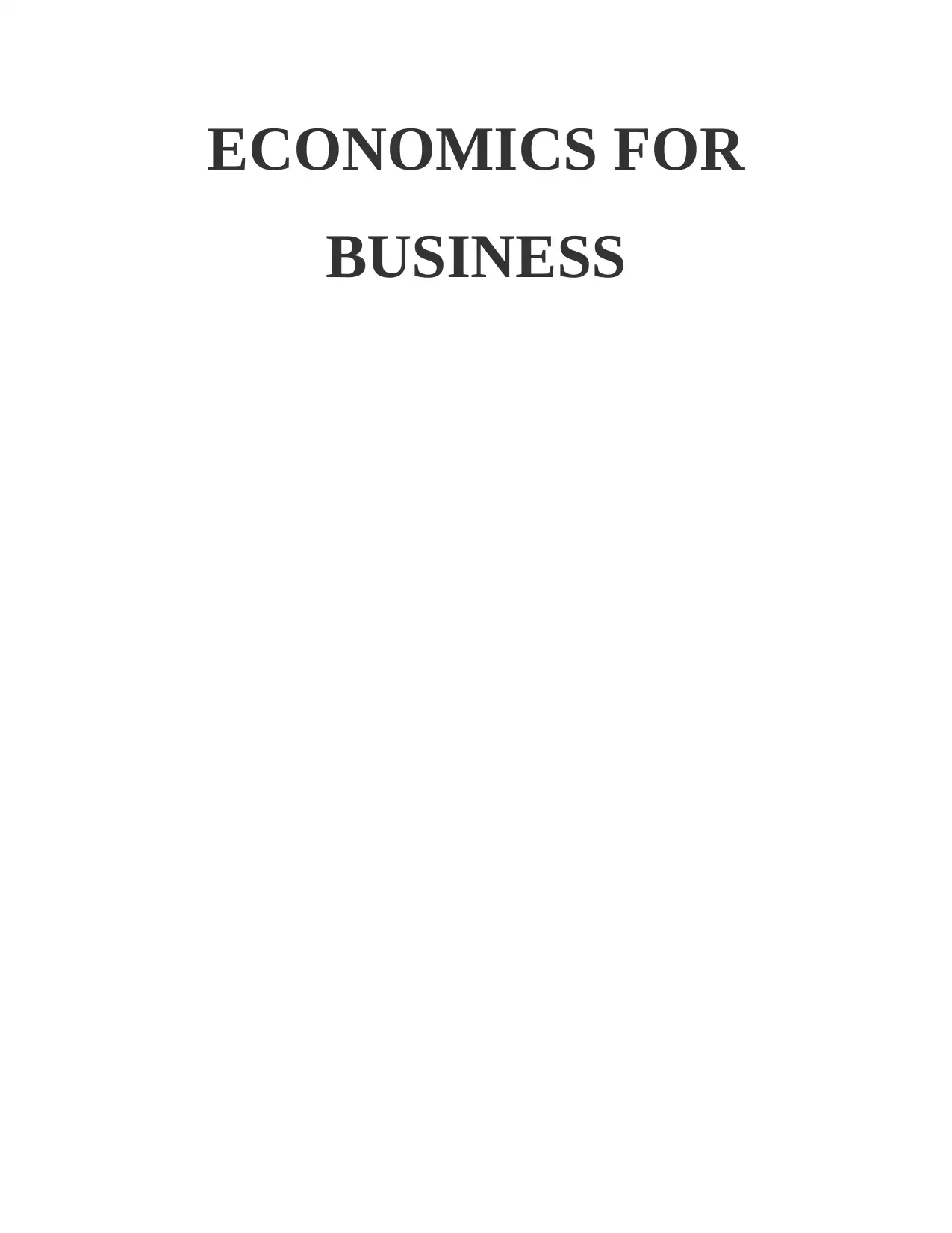
ECONOMICS FOR
BUSINESS
BUSINESS
Paraphrase This Document
Need a fresh take? Get an instant paraphrase of this document with our AI Paraphraser
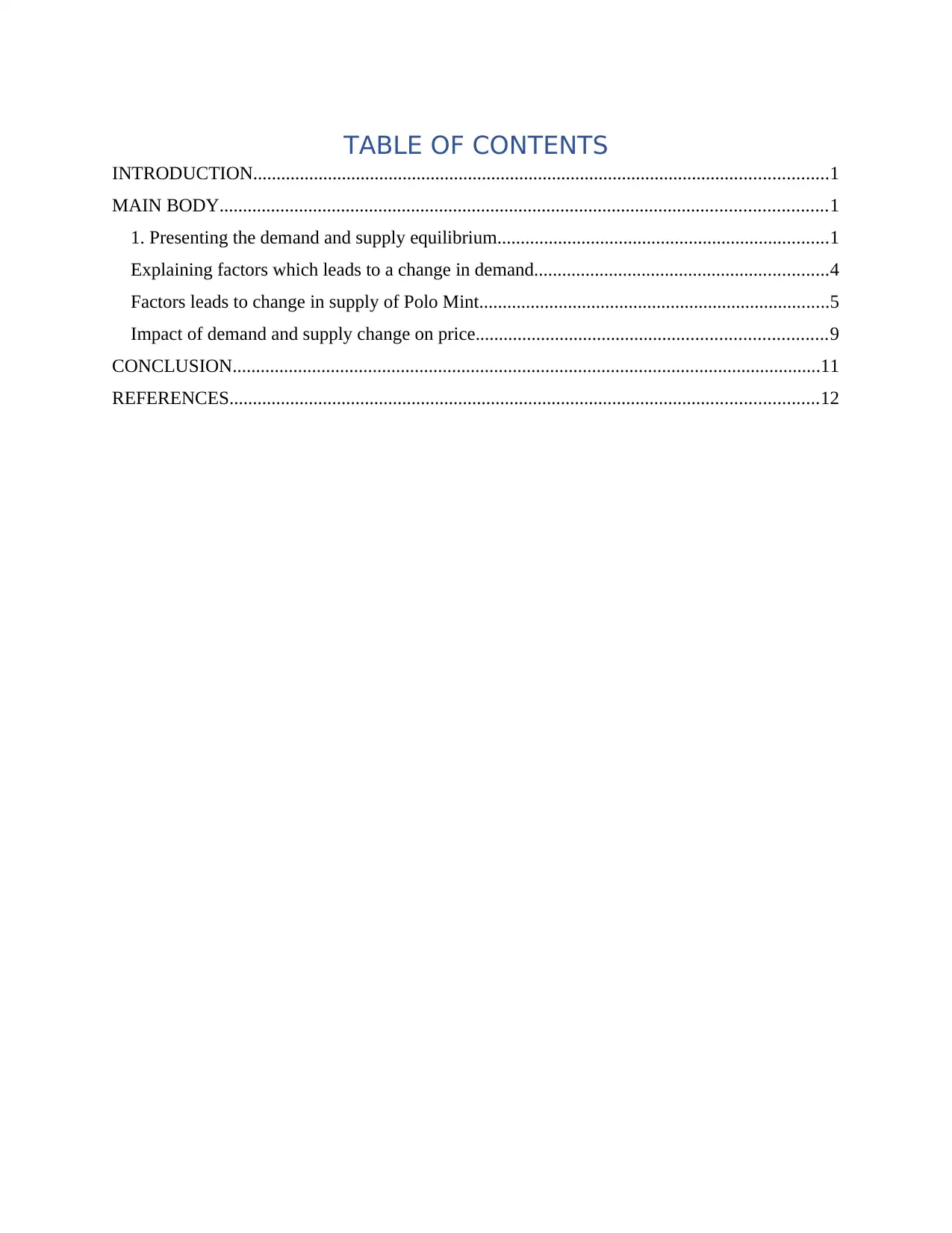
TABLE OF CONTENTS
INTRODUCTION...........................................................................................................................1
MAIN BODY..................................................................................................................................1
1. Presenting the demand and supply equilibrium.......................................................................1
Explaining factors which leads to a change in demand...............................................................4
Factors leads to change in supply of Polo Mint...........................................................................5
Impact of demand and supply change on price...........................................................................9
CONCLUSION..............................................................................................................................11
REFERENCES..............................................................................................................................12
INTRODUCTION...........................................................................................................................1
MAIN BODY..................................................................................................................................1
1. Presenting the demand and supply equilibrium.......................................................................1
Explaining factors which leads to a change in demand...............................................................4
Factors leads to change in supply of Polo Mint...........................................................................5
Impact of demand and supply change on price...........................................................................9
CONCLUSION..............................................................................................................................11
REFERENCES..............................................................................................................................12
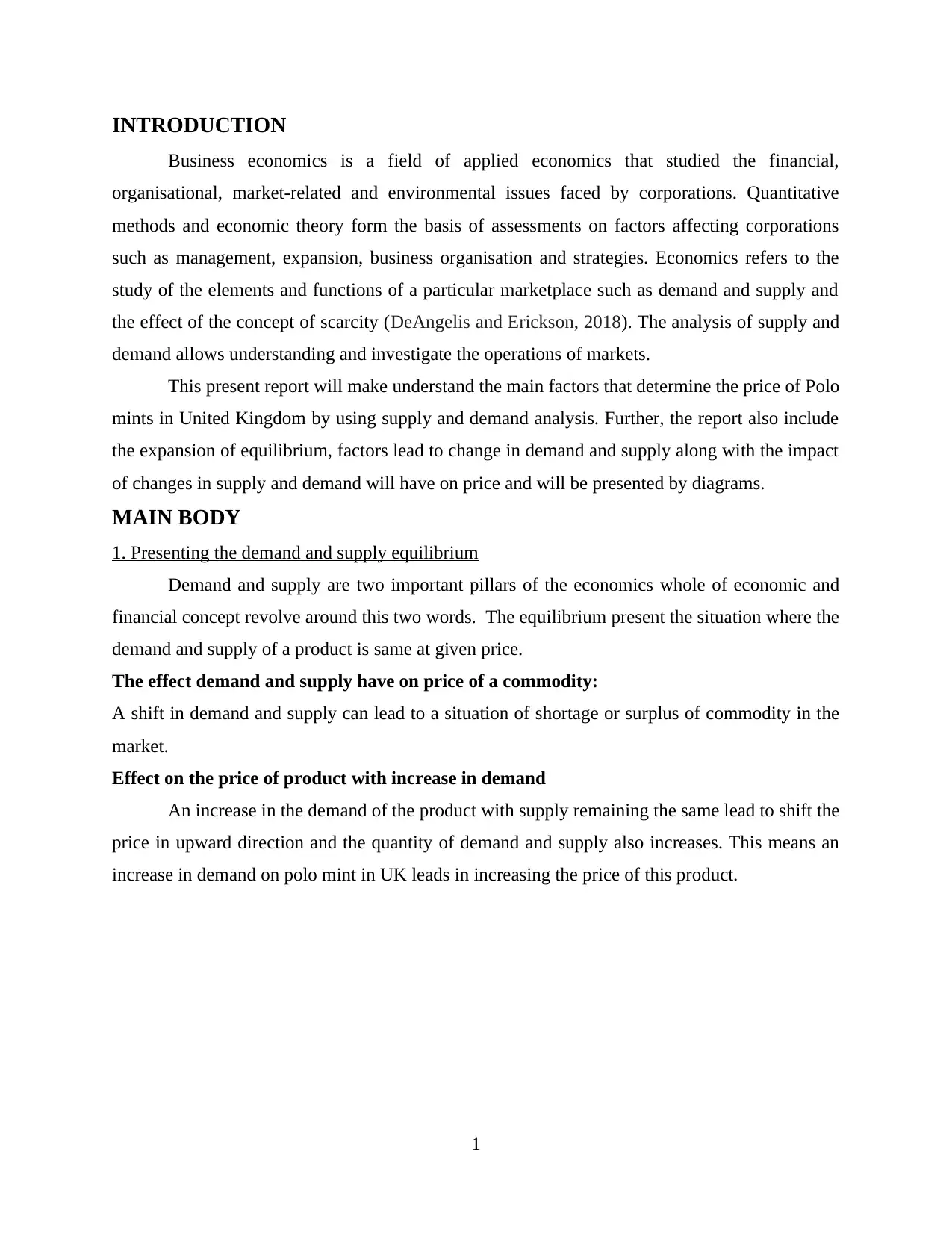
INTRODUCTION
Business economics is a field of applied economics that studied the financial,
organisational, market-related and environmental issues faced by corporations. Quantitative
methods and economic theory form the basis of assessments on factors affecting corporations
such as management, expansion, business organisation and strategies. Economics refers to the
study of the elements and functions of a particular marketplace such as demand and supply and
the effect of the concept of scarcity (DeAngelis and Erickson, 2018). The analysis of supply and
demand allows understanding and investigate the operations of markets.
This present report will make understand the main factors that determine the price of Polo
mints in United Kingdom by using supply and demand analysis. Further, the report also include
the expansion of equilibrium, factors lead to change in demand and supply along with the impact
of changes in supply and demand will have on price and will be presented by diagrams.
MAIN BODY
1. Presenting the demand and supply equilibrium
Demand and supply are two important pillars of the economics whole of economic and
financial concept revolve around this two words. The equilibrium present the situation where the
demand and supply of a product is same at given price.
The effect demand and supply have on price of a commodity:
A shift in demand and supply can lead to a situation of shortage or surplus of commodity in the
market.
Effect on the price of product with increase in demand
An increase in the demand of the product with supply remaining the same lead to shift the
price in upward direction and the quantity of demand and supply also increases. This means an
increase in demand on polo mint in UK leads in increasing the price of this product.
1
Business economics is a field of applied economics that studied the financial,
organisational, market-related and environmental issues faced by corporations. Quantitative
methods and economic theory form the basis of assessments on factors affecting corporations
such as management, expansion, business organisation and strategies. Economics refers to the
study of the elements and functions of a particular marketplace such as demand and supply and
the effect of the concept of scarcity (DeAngelis and Erickson, 2018). The analysis of supply and
demand allows understanding and investigate the operations of markets.
This present report will make understand the main factors that determine the price of Polo
mints in United Kingdom by using supply and demand analysis. Further, the report also include
the expansion of equilibrium, factors lead to change in demand and supply along with the impact
of changes in supply and demand will have on price and will be presented by diagrams.
MAIN BODY
1. Presenting the demand and supply equilibrium
Demand and supply are two important pillars of the economics whole of economic and
financial concept revolve around this two words. The equilibrium present the situation where the
demand and supply of a product is same at given price.
The effect demand and supply have on price of a commodity:
A shift in demand and supply can lead to a situation of shortage or surplus of commodity in the
market.
Effect on the price of product with increase in demand
An increase in the demand of the product with supply remaining the same lead to shift the
price in upward direction and the quantity of demand and supply also increases. This means an
increase in demand on polo mint in UK leads in increasing the price of this product.
1
⊘ This is a preview!⊘
Do you want full access?
Subscribe today to unlock all pages.

Trusted by 1+ million students worldwide
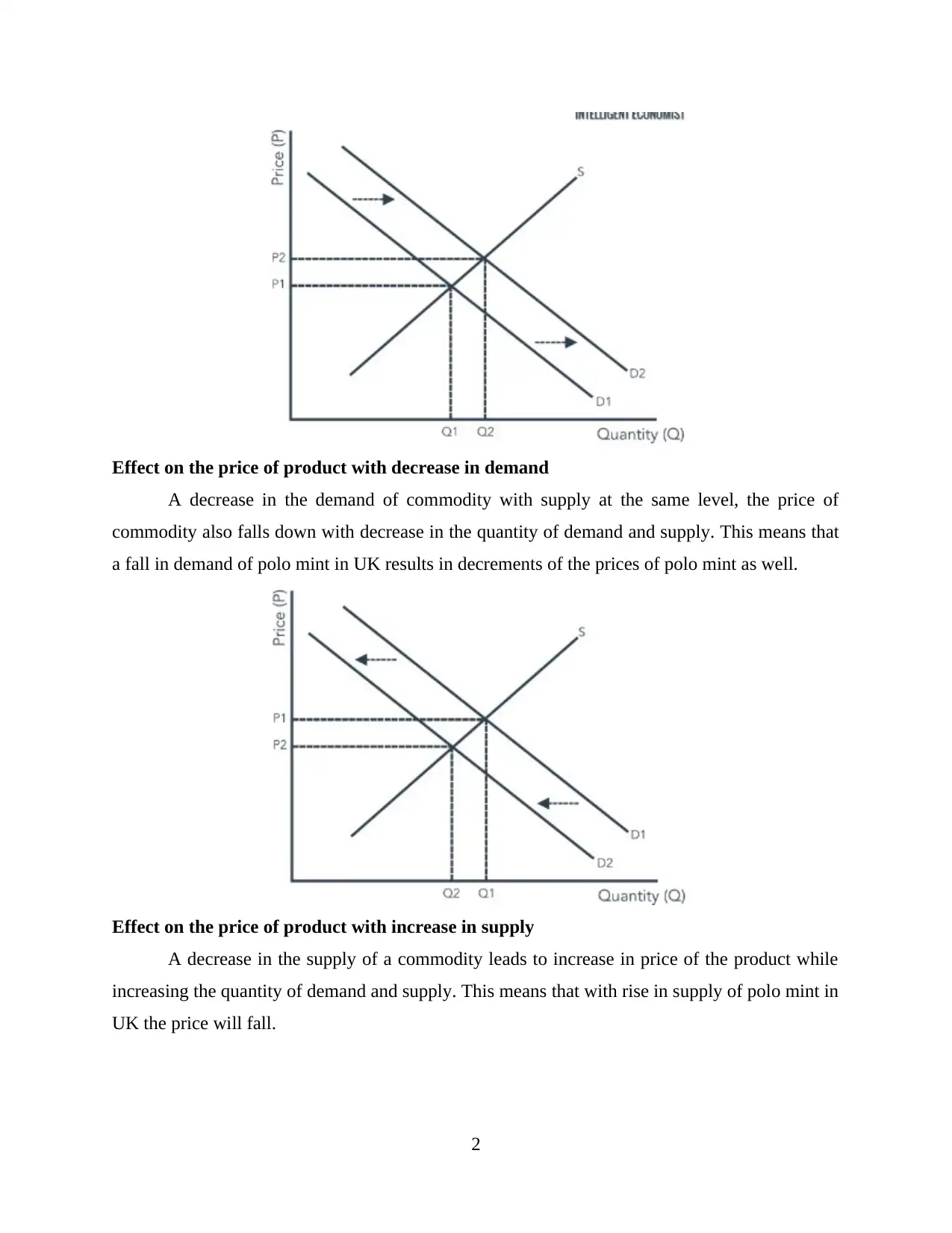
Effect on the price of product with decrease in demand
A decrease in the demand of commodity with supply at the same level, the price of
commodity also falls down with decrease in the quantity of demand and supply. This means that
a fall in demand of polo mint in UK results in decrements of the prices of polo mint as well.
Effect on the price of product with increase in supply
A decrease in the supply of a commodity leads to increase in price of the product while
increasing the quantity of demand and supply. This means that with rise in supply of polo mint in
UK the price will fall.
2
A decrease in the demand of commodity with supply at the same level, the price of
commodity also falls down with decrease in the quantity of demand and supply. This means that
a fall in demand of polo mint in UK results in decrements of the prices of polo mint as well.
Effect on the price of product with increase in supply
A decrease in the supply of a commodity leads to increase in price of the product while
increasing the quantity of demand and supply. This means that with rise in supply of polo mint in
UK the price will fall.
2
Paraphrase This Document
Need a fresh take? Get an instant paraphrase of this document with our AI Paraphraser
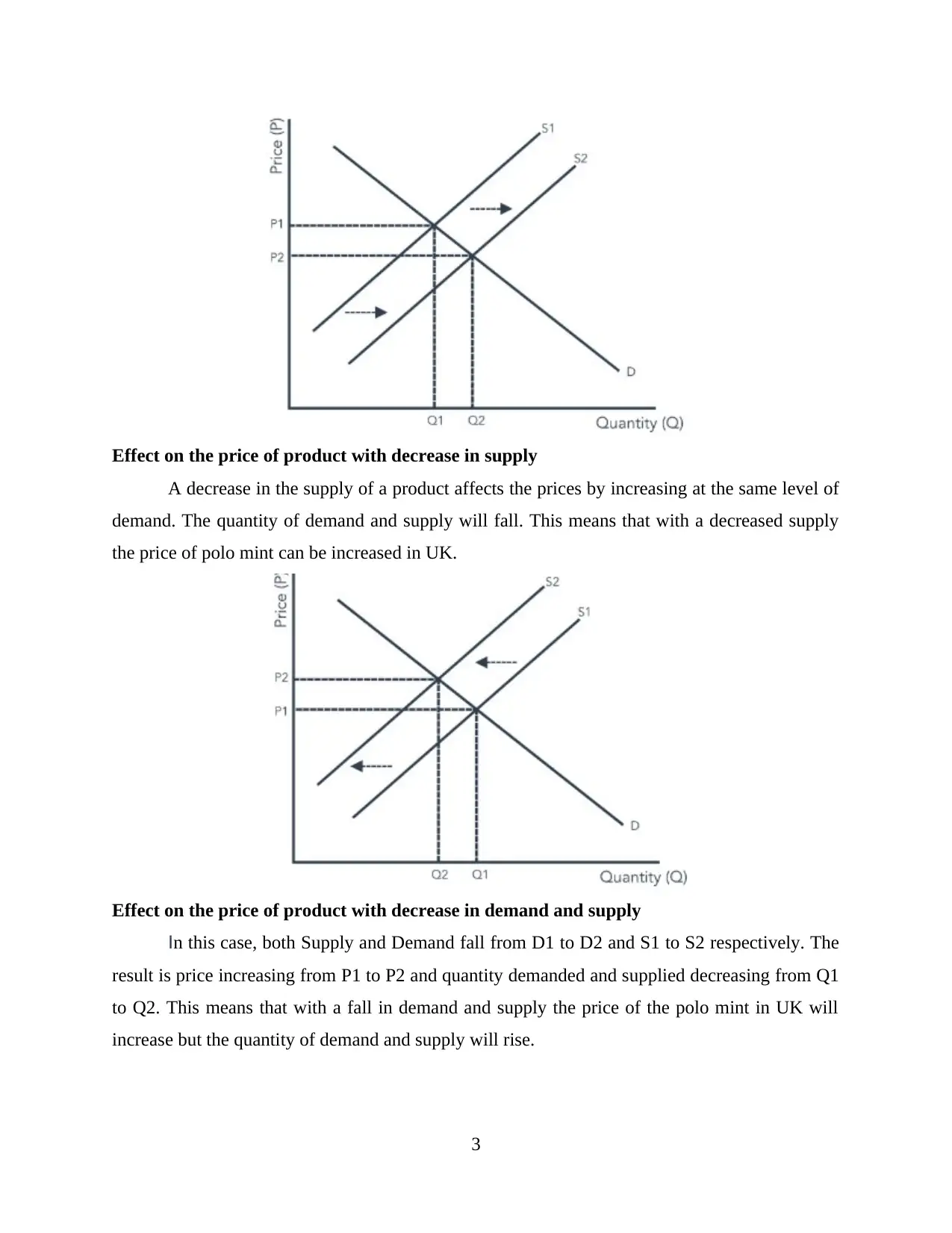
Effect on the price of product with decrease in supply
A decrease in the supply of a product affects the prices by increasing at the same level of
demand. The quantity of demand and supply will fall. This means that with a decreased supply
the price of polo mint can be increased in UK.
Effect on the price of product with decrease in demand and supply
In this case, both Supply and Demand fall from D1 to D2 and S1 to S2 respectively. The
result is price increasing from P1 to P2 and quantity demanded and supplied decreasing from Q1
to Q2. This means that with a fall in demand and supply the price of the polo mint in UK will
increase but the quantity of demand and supply will rise.
3
A decrease in the supply of a product affects the prices by increasing at the same level of
demand. The quantity of demand and supply will fall. This means that with a decreased supply
the price of polo mint can be increased in UK.
Effect on the price of product with decrease in demand and supply
In this case, both Supply and Demand fall from D1 to D2 and S1 to S2 respectively. The
result is price increasing from P1 to P2 and quantity demanded and supplied decreasing from Q1
to Q2. This means that with a fall in demand and supply the price of the polo mint in UK will
increase but the quantity of demand and supply will rise.
3
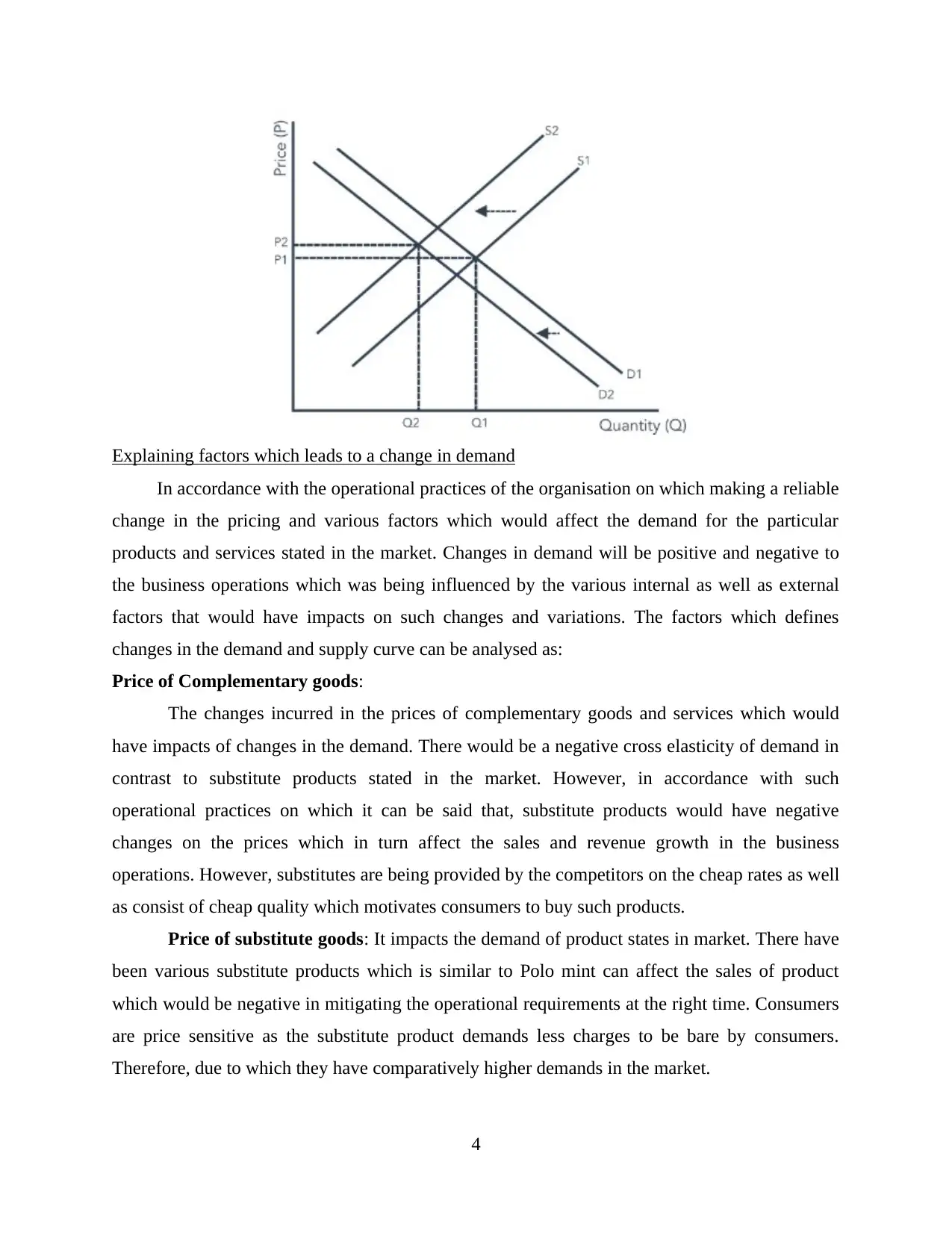
Explaining factors which leads to a change in demand
In accordance with the operational practices of the organisation on which making a reliable
change in the pricing and various factors which would affect the demand for the particular
products and services stated in the market. Changes in demand will be positive and negative to
the business operations which was being influenced by the various internal as well as external
factors that would have impacts on such changes and variations. The factors which defines
changes in the demand and supply curve can be analysed as:
Price of Complementary goods:
The changes incurred in the prices of complementary goods and services which would
have impacts of changes in the demand. There would be a negative cross elasticity of demand in
contrast to substitute products stated in the market. However, in accordance with such
operational practices on which it can be said that, substitute products would have negative
changes on the prices which in turn affect the sales and revenue growth in the business
operations. However, substitutes are being provided by the competitors on the cheap rates as well
as consist of cheap quality which motivates consumers to buy such products.
Price of substitute goods: It impacts the demand of product states in market. There have
been various substitute products which is similar to Polo mint can affect the sales of product
which would be negative in mitigating the operational requirements at the right time. Consumers
are price sensitive as the substitute product demands less charges to be bare by consumers.
Therefore, due to which they have comparatively higher demands in the market.
4
In accordance with the operational practices of the organisation on which making a reliable
change in the pricing and various factors which would affect the demand for the particular
products and services stated in the market. Changes in demand will be positive and negative to
the business operations which was being influenced by the various internal as well as external
factors that would have impacts on such changes and variations. The factors which defines
changes in the demand and supply curve can be analysed as:
Price of Complementary goods:
The changes incurred in the prices of complementary goods and services which would
have impacts of changes in the demand. There would be a negative cross elasticity of demand in
contrast to substitute products stated in the market. However, in accordance with such
operational practices on which it can be said that, substitute products would have negative
changes on the prices which in turn affect the sales and revenue growth in the business
operations. However, substitutes are being provided by the competitors on the cheap rates as well
as consist of cheap quality which motivates consumers to buy such products.
Price of substitute goods: It impacts the demand of product states in market. There have
been various substitute products which is similar to Polo mint can affect the sales of product
which would be negative in mitigating the operational requirements at the right time. Consumers
are price sensitive as the substitute product demands less charges to be bare by consumers.
Therefore, due to which they have comparatively higher demands in the market.
4
⊘ This is a preview!⊘
Do you want full access?
Subscribe today to unlock all pages.

Trusted by 1+ million students worldwide
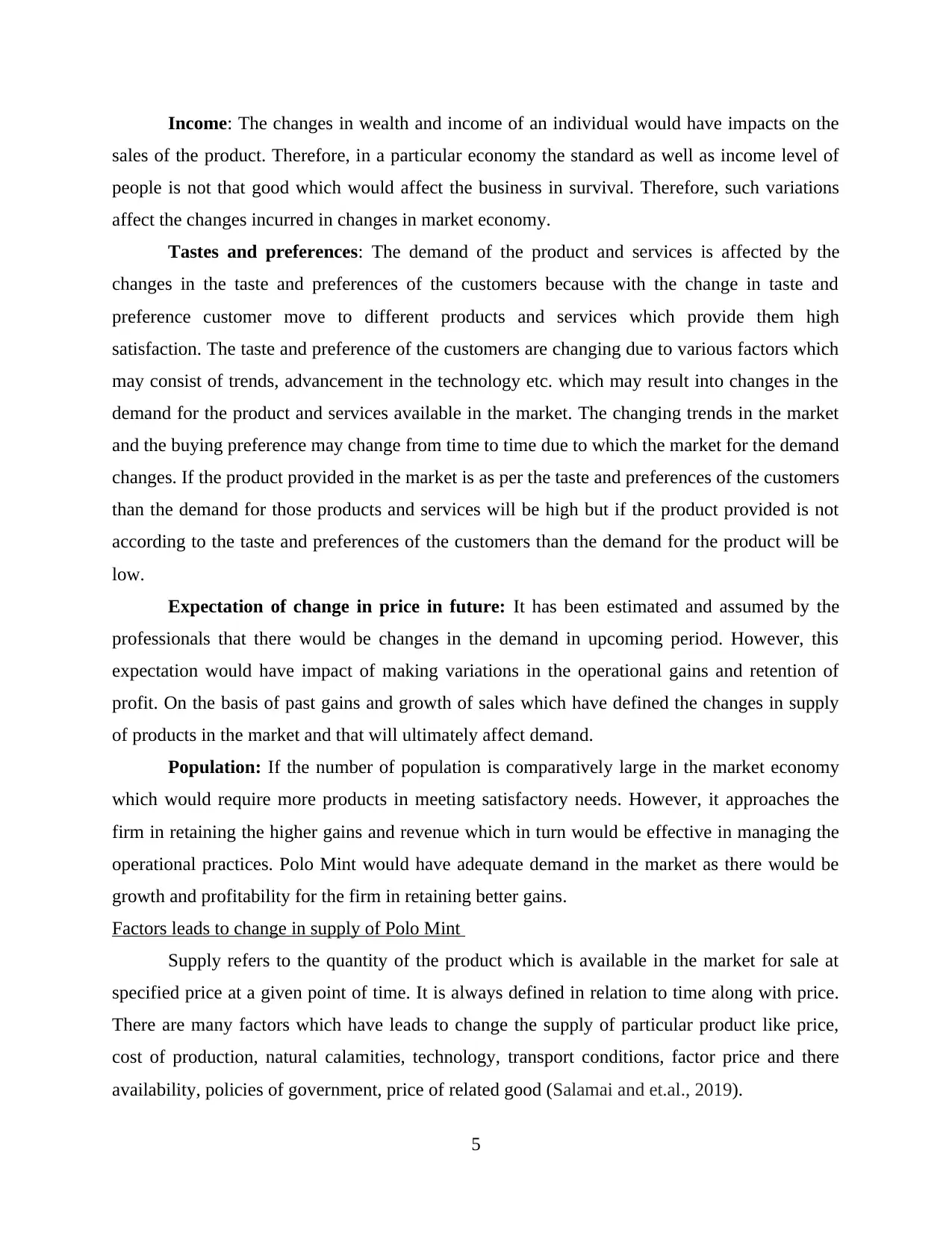
Income: The changes in wealth and income of an individual would have impacts on the
sales of the product. Therefore, in a particular economy the standard as well as income level of
people is not that good which would affect the business in survival. Therefore, such variations
affect the changes incurred in changes in market economy.
Tastes and preferences: The demand of the product and services is affected by the
changes in the taste and preferences of the customers because with the change in taste and
preference customer move to different products and services which provide them high
satisfaction. The taste and preference of the customers are changing due to various factors which
may consist of trends, advancement in the technology etc. which may result into changes in the
demand for the product and services available in the market. The changing trends in the market
and the buying preference may change from time to time due to which the market for the demand
changes. If the product provided in the market is as per the taste and preferences of the customers
than the demand for those products and services will be high but if the product provided is not
according to the taste and preferences of the customers than the demand for the product will be
low.
Expectation of change in price in future: It has been estimated and assumed by the
professionals that there would be changes in the demand in upcoming period. However, this
expectation would have impact of making variations in the operational gains and retention of
profit. On the basis of past gains and growth of sales which have defined the changes in supply
of products in the market and that will ultimately affect demand.
Population: If the number of population is comparatively large in the market economy
which would require more products in meeting satisfactory needs. However, it approaches the
firm in retaining the higher gains and revenue which in turn would be effective in managing the
operational practices. Polo Mint would have adequate demand in the market as there would be
growth and profitability for the firm in retaining better gains.
Factors leads to change in supply of Polo Mint
Supply refers to the quantity of the product which is available in the market for sale at
specified price at a given point of time. It is always defined in relation to time along with price.
There are many factors which have leads to change the supply of particular product like price,
cost of production, natural calamities, technology, transport conditions, factor price and there
availability, policies of government, price of related good (Salamai and et.al., 2019).
5
sales of the product. Therefore, in a particular economy the standard as well as income level of
people is not that good which would affect the business in survival. Therefore, such variations
affect the changes incurred in changes in market economy.
Tastes and preferences: The demand of the product and services is affected by the
changes in the taste and preferences of the customers because with the change in taste and
preference customer move to different products and services which provide them high
satisfaction. The taste and preference of the customers are changing due to various factors which
may consist of trends, advancement in the technology etc. which may result into changes in the
demand for the product and services available in the market. The changing trends in the market
and the buying preference may change from time to time due to which the market for the demand
changes. If the product provided in the market is as per the taste and preferences of the customers
than the demand for those products and services will be high but if the product provided is not
according to the taste and preferences of the customers than the demand for the product will be
low.
Expectation of change in price in future: It has been estimated and assumed by the
professionals that there would be changes in the demand in upcoming period. However, this
expectation would have impact of making variations in the operational gains and retention of
profit. On the basis of past gains and growth of sales which have defined the changes in supply
of products in the market and that will ultimately affect demand.
Population: If the number of population is comparatively large in the market economy
which would require more products in meeting satisfactory needs. However, it approaches the
firm in retaining the higher gains and revenue which in turn would be effective in managing the
operational practices. Polo Mint would have adequate demand in the market as there would be
growth and profitability for the firm in retaining better gains.
Factors leads to change in supply of Polo Mint
Supply refers to the quantity of the product which is available in the market for sale at
specified price at a given point of time. It is always defined in relation to time along with price.
There are many factors which have leads to change the supply of particular product like price,
cost of production, natural calamities, technology, transport conditions, factor price and there
availability, policies of government, price of related good (Salamai and et.al., 2019).
5
Paraphrase This Document
Need a fresh take? Get an instant paraphrase of this document with our AI Paraphraser
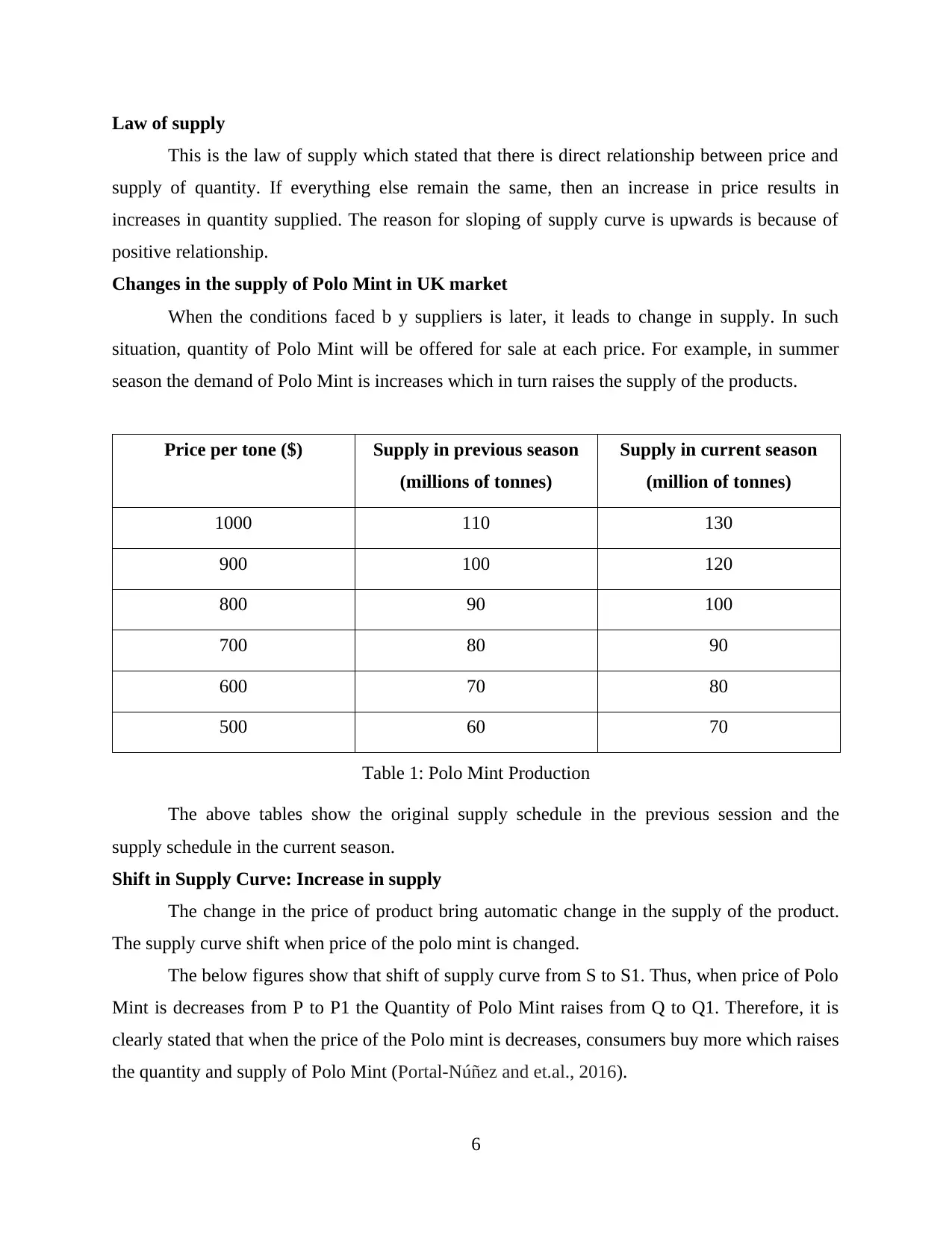
Law of supply
This is the law of supply which stated that there is direct relationship between price and
supply of quantity. If everything else remain the same, then an increase in price results in
increases in quantity supplied. The reason for sloping of supply curve is upwards is because of
positive relationship.
Changes in the supply of Polo Mint in UK market
When the conditions faced b y suppliers is later, it leads to change in supply. In such
situation, quantity of Polo Mint will be offered for sale at each price. For example, in summer
season the demand of Polo Mint is increases which in turn raises the supply of the products.
Price per tone ($) Supply in previous season
(millions of tonnes)
Supply in current season
(million of tonnes)
1000 110 130
900 100 120
800 90 100
700 80 90
600 70 80
500 60 70
Table 1: Polo Mint Production
The above tables show the original supply schedule in the previous session and the
supply schedule in the current season.
Shift in Supply Curve: Increase in supply
The change in the price of product bring automatic change in the supply of the product.
The supply curve shift when price of the polo mint is changed.
The below figures show that shift of supply curve from S to S1. Thus, when price of Polo
Mint is decreases from P to P1 the Quantity of Polo Mint raises from Q to Q1. Therefore, it is
clearly stated that when the price of the Polo mint is decreases, consumers buy more which raises
the quantity and supply of Polo Mint (Portal-Núñez and et.al., 2016).
6
This is the law of supply which stated that there is direct relationship between price and
supply of quantity. If everything else remain the same, then an increase in price results in
increases in quantity supplied. The reason for sloping of supply curve is upwards is because of
positive relationship.
Changes in the supply of Polo Mint in UK market
When the conditions faced b y suppliers is later, it leads to change in supply. In such
situation, quantity of Polo Mint will be offered for sale at each price. For example, in summer
season the demand of Polo Mint is increases which in turn raises the supply of the products.
Price per tone ($) Supply in previous season
(millions of tonnes)
Supply in current season
(million of tonnes)
1000 110 130
900 100 120
800 90 100
700 80 90
600 70 80
500 60 70
Table 1: Polo Mint Production
The above tables show the original supply schedule in the previous session and the
supply schedule in the current season.
Shift in Supply Curve: Increase in supply
The change in the price of product bring automatic change in the supply of the product.
The supply curve shift when price of the polo mint is changed.
The below figures show that shift of supply curve from S to S1. Thus, when price of Polo
Mint is decreases from P to P1 the Quantity of Polo Mint raises from Q to Q1. Therefore, it is
clearly stated that when the price of the Polo mint is decreases, consumers buy more which raises
the quantity and supply of Polo Mint (Portal-Núñez and et.al., 2016).
6

7
⊘ This is a preview!⊘
Do you want full access?
Subscribe today to unlock all pages.

Trusted by 1+ million students worldwide
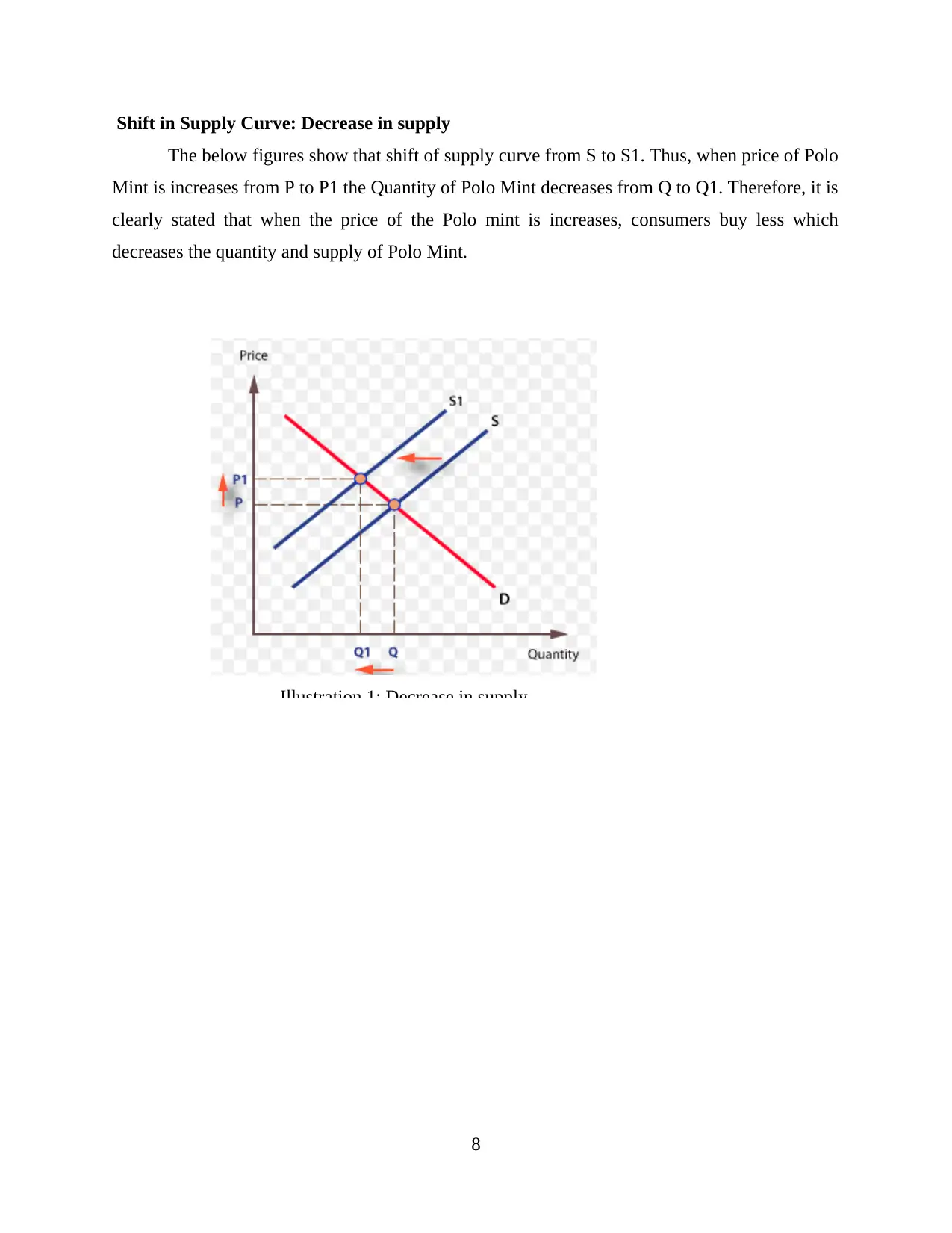
Shift in Supply Curve: Decrease in supply
The below figures show that shift of supply curve from S to S1. Thus, when price of Polo
Mint is increases from P to P1 the Quantity of Polo Mint decreases from Q to Q1. Therefore, it is
clearly stated that when the price of the Polo mint is increases, consumers buy less which
decreases the quantity and supply of Polo Mint.
8
Illustration 1: Decrease in supply
The below figures show that shift of supply curve from S to S1. Thus, when price of Polo
Mint is increases from P to P1 the Quantity of Polo Mint decreases from Q to Q1. Therefore, it is
clearly stated that when the price of the Polo mint is increases, consumers buy less which
decreases the quantity and supply of Polo Mint.
8
Illustration 1: Decrease in supply
Paraphrase This Document
Need a fresh take? Get an instant paraphrase of this document with our AI Paraphraser
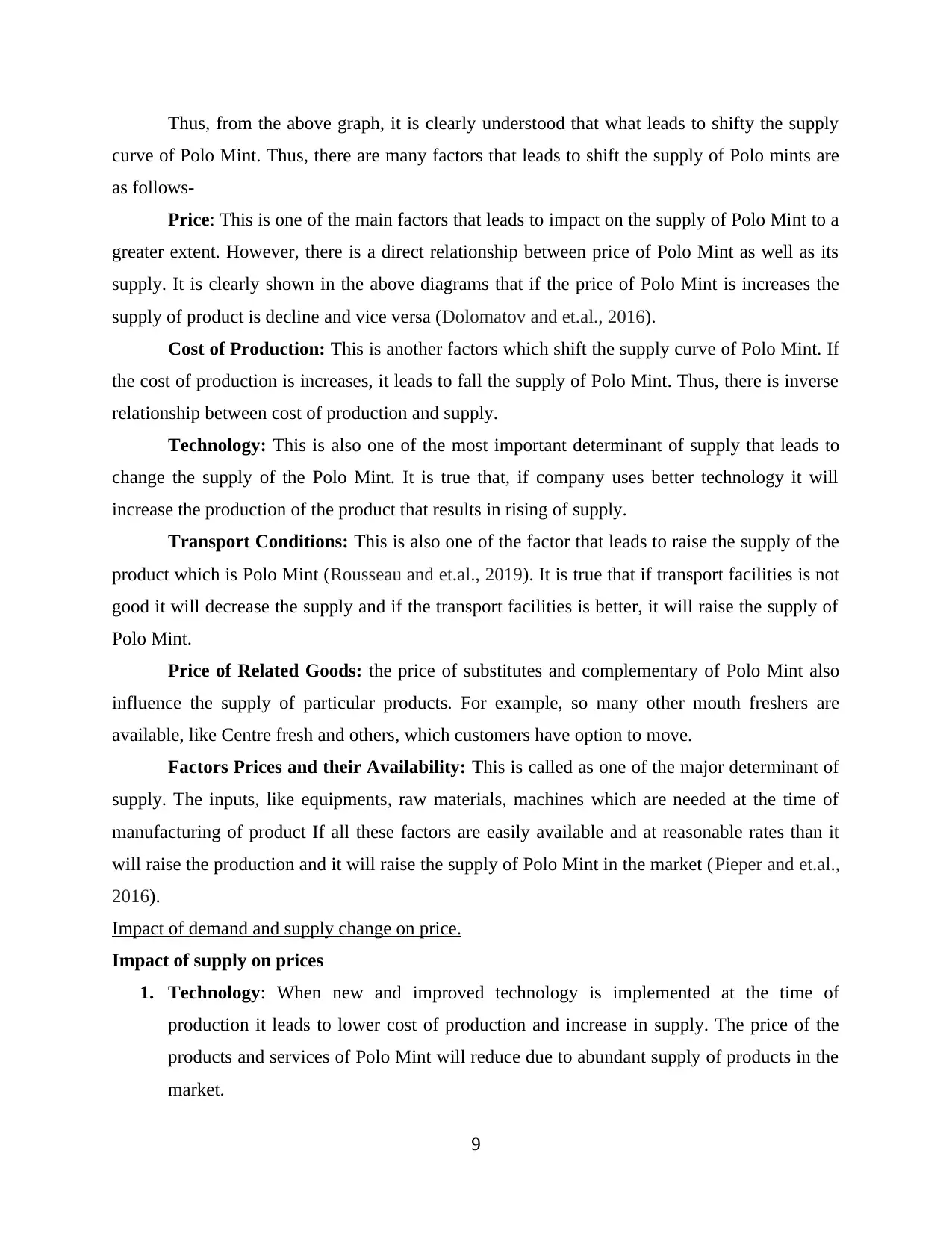
Thus, from the above graph, it is clearly understood that what leads to shifty the supply
curve of Polo Mint. Thus, there are many factors that leads to shift the supply of Polo mints are
as follows-
Price: This is one of the main factors that leads to impact on the supply of Polo Mint to a
greater extent. However, there is a direct relationship between price of Polo Mint as well as its
supply. It is clearly shown in the above diagrams that if the price of Polo Mint is increases the
supply of product is decline and vice versa (Dolomatov and et.al., 2016).
Cost of Production: This is another factors which shift the supply curve of Polo Mint. If
the cost of production is increases, it leads to fall the supply of Polo Mint. Thus, there is inverse
relationship between cost of production and supply.
Technology: This is also one of the most important determinant of supply that leads to
change the supply of the Polo Mint. It is true that, if company uses better technology it will
increase the production of the product that results in rising of supply.
Transport Conditions: This is also one of the factor that leads to raise the supply of the
product which is Polo Mint (Rousseau and et.al., 2019). It is true that if transport facilities is not
good it will decrease the supply and if the transport facilities is better, it will raise the supply of
Polo Mint.
Price of Related Goods: the price of substitutes and complementary of Polo Mint also
influence the supply of particular products. For example, so many other mouth freshers are
available, like Centre fresh and others, which customers have option to move.
Factors Prices and their Availability: This is called as one of the major determinant of
supply. The inputs, like equipments, raw materials, machines which are needed at the time of
manufacturing of product If all these factors are easily available and at reasonable rates than it
will raise the production and it will raise the supply of Polo Mint in the market (Pieper and et.al.,
2016).
Impact of demand and supply change on price.
Impact of supply on prices
1. Technology: When new and improved technology is implemented at the time of
production it leads to lower cost of production and increase in supply. The price of the
products and services of Polo Mint will reduce due to abundant supply of products in the
market.
9
curve of Polo Mint. Thus, there are many factors that leads to shift the supply of Polo mints are
as follows-
Price: This is one of the main factors that leads to impact on the supply of Polo Mint to a
greater extent. However, there is a direct relationship between price of Polo Mint as well as its
supply. It is clearly shown in the above diagrams that if the price of Polo Mint is increases the
supply of product is decline and vice versa (Dolomatov and et.al., 2016).
Cost of Production: This is another factors which shift the supply curve of Polo Mint. If
the cost of production is increases, it leads to fall the supply of Polo Mint. Thus, there is inverse
relationship between cost of production and supply.
Technology: This is also one of the most important determinant of supply that leads to
change the supply of the Polo Mint. It is true that, if company uses better technology it will
increase the production of the product that results in rising of supply.
Transport Conditions: This is also one of the factor that leads to raise the supply of the
product which is Polo Mint (Rousseau and et.al., 2019). It is true that if transport facilities is not
good it will decrease the supply and if the transport facilities is better, it will raise the supply of
Polo Mint.
Price of Related Goods: the price of substitutes and complementary of Polo Mint also
influence the supply of particular products. For example, so many other mouth freshers are
available, like Centre fresh and others, which customers have option to move.
Factors Prices and their Availability: This is called as one of the major determinant of
supply. The inputs, like equipments, raw materials, machines which are needed at the time of
manufacturing of product If all these factors are easily available and at reasonable rates than it
will raise the production and it will raise the supply of Polo Mint in the market (Pieper and et.al.,
2016).
Impact of demand and supply change on price.
Impact of supply on prices
1. Technology: When new and improved technology is implemented at the time of
production it leads to lower cost of production and increase in supply. The price of the
products and services of Polo Mint will reduce due to abundant supply of products in the
market.
9
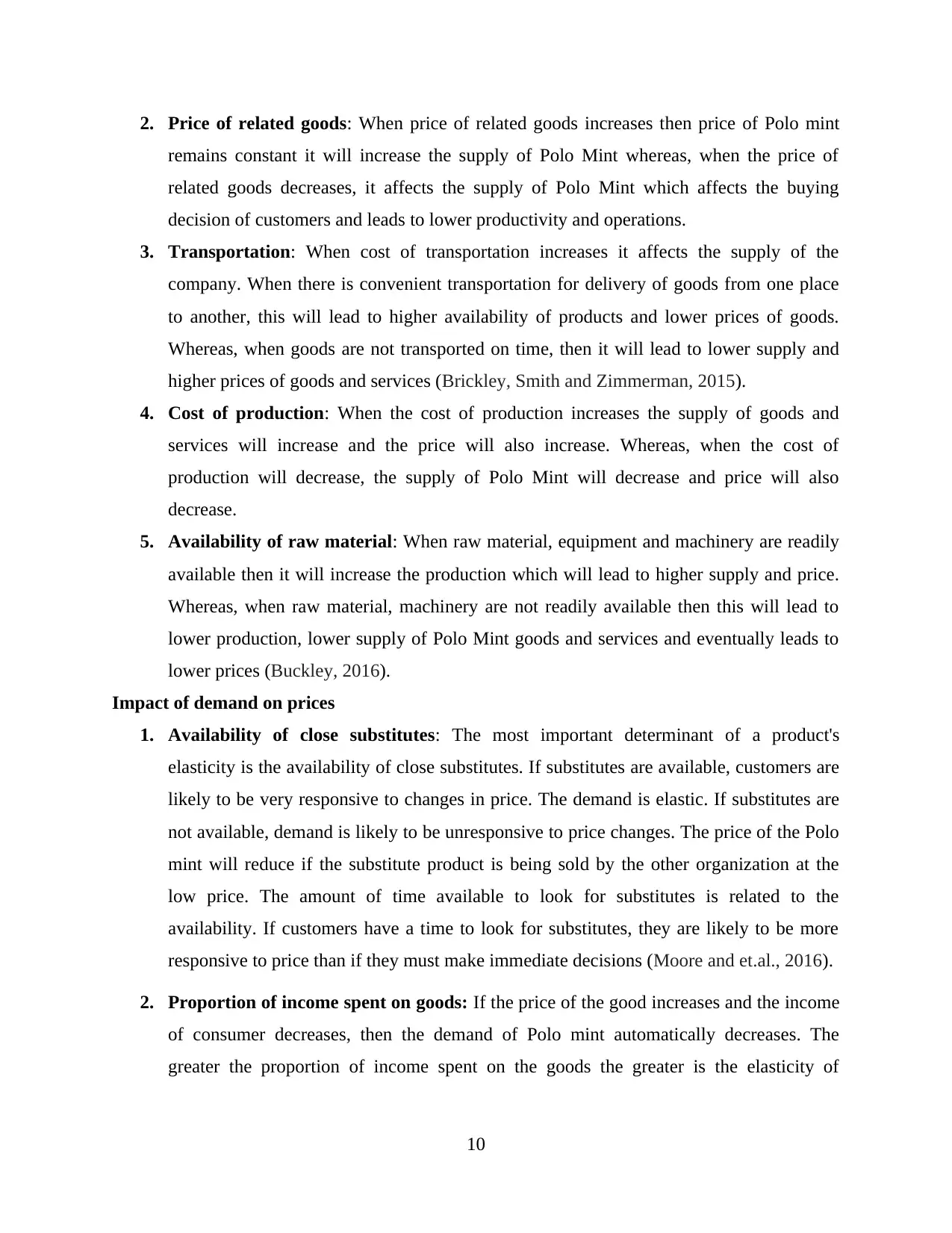
2. Price of related goods: When price of related goods increases then price of Polo mint
remains constant it will increase the supply of Polo Mint whereas, when the price of
related goods decreases, it affects the supply of Polo Mint which affects the buying
decision of customers and leads to lower productivity and operations.
3. Transportation: When cost of transportation increases it affects the supply of the
company. When there is convenient transportation for delivery of goods from one place
to another, this will lead to higher availability of products and lower prices of goods.
Whereas, when goods are not transported on time, then it will lead to lower supply and
higher prices of goods and services (Brickley, Smith and Zimmerman, 2015).
4. Cost of production: When the cost of production increases the supply of goods and
services will increase and the price will also increase. Whereas, when the cost of
production will decrease, the supply of Polo Mint will decrease and price will also
decrease.
5. Availability of raw material: When raw material, equipment and machinery are readily
available then it will increase the production which will lead to higher supply and price.
Whereas, when raw material, machinery are not readily available then this will lead to
lower production, lower supply of Polo Mint goods and services and eventually leads to
lower prices (Buckley, 2016).
Impact of demand on prices
1. Availability of close substitutes: The most important determinant of a product's
elasticity is the availability of close substitutes. If substitutes are available, customers are
likely to be very responsive to changes in price. The demand is elastic. If substitutes are
not available, demand is likely to be unresponsive to price changes. The price of the Polo
mint will reduce if the substitute product is being sold by the other organization at the
low price. The amount of time available to look for substitutes is related to the
availability. If customers have a time to look for substitutes, they are likely to be more
responsive to price than if they must make immediate decisions (Moore and et.al., 2016).
2. Proportion of income spent on goods: If the price of the good increases and the income
of consumer decreases, then the demand of Polo mint automatically decreases. The
greater the proportion of income spent on the goods the greater is the elasticity of
10
remains constant it will increase the supply of Polo Mint whereas, when the price of
related goods decreases, it affects the supply of Polo Mint which affects the buying
decision of customers and leads to lower productivity and operations.
3. Transportation: When cost of transportation increases it affects the supply of the
company. When there is convenient transportation for delivery of goods from one place
to another, this will lead to higher availability of products and lower prices of goods.
Whereas, when goods are not transported on time, then it will lead to lower supply and
higher prices of goods and services (Brickley, Smith and Zimmerman, 2015).
4. Cost of production: When the cost of production increases the supply of goods and
services will increase and the price will also increase. Whereas, when the cost of
production will decrease, the supply of Polo Mint will decrease and price will also
decrease.
5. Availability of raw material: When raw material, equipment and machinery are readily
available then it will increase the production which will lead to higher supply and price.
Whereas, when raw material, machinery are not readily available then this will lead to
lower production, lower supply of Polo Mint goods and services and eventually leads to
lower prices (Buckley, 2016).
Impact of demand on prices
1. Availability of close substitutes: The most important determinant of a product's
elasticity is the availability of close substitutes. If substitutes are available, customers are
likely to be very responsive to changes in price. The demand is elastic. If substitutes are
not available, demand is likely to be unresponsive to price changes. The price of the Polo
mint will reduce if the substitute product is being sold by the other organization at the
low price. The amount of time available to look for substitutes is related to the
availability. If customers have a time to look for substitutes, they are likely to be more
responsive to price than if they must make immediate decisions (Moore and et.al., 2016).
2. Proportion of income spent on goods: If the price of the good increases and the income
of consumer decreases, then the demand of Polo mint automatically decreases. The
greater the proportion of income spent on the goods the greater is the elasticity of
10
⊘ This is a preview!⊘
Do you want full access?
Subscribe today to unlock all pages.

Trusted by 1+ million students worldwide
1 out of 15
Related Documents
Your All-in-One AI-Powered Toolkit for Academic Success.
+13062052269
info@desklib.com
Available 24*7 on WhatsApp / Email
![[object Object]](/_next/static/media/star-bottom.7253800d.svg)
Unlock your academic potential
Copyright © 2020–2025 A2Z Services. All Rights Reserved. Developed and managed by ZUCOL.




